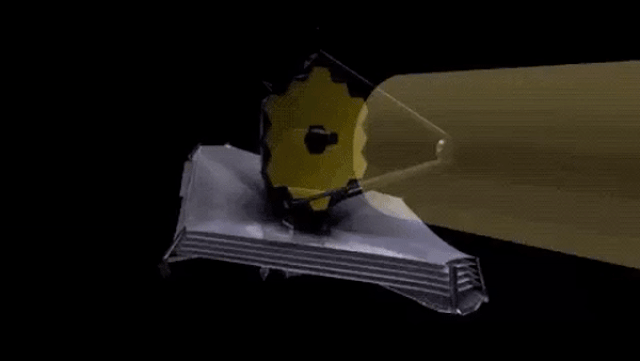NASA's James Webb Space Telescope turns on cameras to look at first star target

Spacecraft controllers have begun powering up the four cutting-edge instruments on NASA's James Webb Space Telescope as they prepare for the observatory's first glimpses of a target star.
That star, called HD 84406, is located 241 light-years from Earth and part of the constellation Ursa Major, the Great Bear. The images will not be used for science, but will help the ground teams align the 18 golden segments of Webb's 21-foot-wide (6.5 meters) main mirror.
The images will be taken by Webb's Near Infrared Camera (NIRCam), which first has to cool down to its operational temperature of minus 244 degrees Fahrenheit (minus 153 degrees Celsius).
"At the beginning, we will have 18 individual blurry images," Mark McCaughrean, a scientist at the JWST Science Working Group and senior advisor at the European Space Agency (ESA), who is familiar with the process, told Space.com. "At the end, we will have one nice sharp image."
Related: James Webb Space Telescope: The engineering behind a 'first light machine' that can't fail
NIRCam will keep staring at HD 84406 while Webb's optics experts move the mirror segments in nanometer-scale steps to create a perfectly smooth surface. This work is expected to last until late April. Only after that will the individual science instruments start fully training their eyes on objects in the near and distant universe. The first proper images are expected to be revealed to the public in late June or early July.
McCaughrean said that none of the other three instruments could take over NIRCam's job in helping to align the mirror. The telescope's success depends on NIRCam and it simply isn't allowed to fail.
Get the Space.com Newsletter
Breaking space news, the latest updates on rocket launches, skywatching events and more!
"If NIRCam failed, we wouldn't be able to align the mirror," said McCaughrean. "That's why it's essentially two cameras in one. There is full redundancy. If one fails, we still have the other."
Of the remaining three instruments, the Mid-Infrared Instrument (MIRI) has already been partially turned on during the telescope's month-long cruise to its destination. In case of the other two — the Near Infrared Spectrograph (NIRSPec) and the Fine Guidance Sensor/Near Infrared Imager and Slitless Spectrograph (FGS/NIRiss) — the control teams have now turned off the heaters that kept them warm during the cruise phase.
These heaters allowed the instruments to gradually release the air trapped inside them and prevent water condensation and ice build-up.
It will take weeks for the instruments to reach their operational temperatures. For MIRI, this temperature is only 10 degrees Fahrenheit (5.5 degrees Celsius ) above absolute zero (minus 460 degrees F or minus 273 degrees C), the coldest possible temperature at which the motion of atoms (which are the source of heat in the universe) stops. The spectrographs can operate at slightly warmer temperatures of minus 393 degrees F (minus 236 degrees C).
These extremely low temperatures are key for Webb to be able to perform its scientific tasks. The telescope was designed to image the oldest stars and galaxies that formed in the universe in the first hundreds of millions of years after the Big Bang. But because of the expansion of the universe, the light emitted by these galaxies is only visible in infrared wavelengths (a result of the so-called redshift). Since infrared light is essentially heat, the dim signal wouldn't be noticeable if the telescope itself radiated any warmth.
While the cameras, like NIRCam and MIRI, will produce stunning images of stars and galaxies, the spectrographs will provide detailed information about the chemical composition of those distant objects, McCaughrean explained.
The James Webb Space Telescope arrived at its destination, the Lagrangian Point 2 (L2), on Jan. 24. L2 is a point on the sun-Earth axis located at a distance of 930,000 miles (1.5 million kilometers) from Earth away from the sun. The gravitational interplay of the two bodies creates stable conditions at L2, which makes it a popular spot for astronomy missions. A spacecraft in this spot orbits the sun in sync with Earth (in practice the James Webb Space Telescope doesn't sit directly at L2 but makes circles around it as it accompanies Earth around the sun).
The James Webb Space Telescope launched on Dec. 25 after a decade of delays. The $10 billion mission, dreamed up by astronomers in the early 1990s, pushed the limits of what's technically possible. Once its mirrors are aligned and instruments calibrated, Webb is expected to revolutionize many areas of astronomy. In addition to the first stars and galaxies, Webb will contribute to the study of exoplanets, star formation, dark matter and even the solar system and its asteroids.
Follow Tereza Pultarova on Twitter @TerezaPultarova. Follow us on Twitter @Spacedotcom and on Facebook.
Join our Space Forums to keep talking space on the latest missions, night sky and more! And if you have a news tip, correction or comment, let us know at: community@space.com.

Tereza is a London-based science and technology journalist, aspiring fiction writer and amateur gymnast. Originally from Prague, the Czech Republic, she spent the first seven years of her career working as a reporter, script-writer and presenter for various TV programmes of the Czech Public Service Television. She later took a career break to pursue further education and added a Master's in Science from the International Space University, France, to her Bachelor's in Journalism and Master's in Cultural Anthropology from Prague's Charles University. She worked as a reporter at the Engineering and Technology magazine, freelanced for a range of publications including Live Science, Space.com, Professional Engineering, Via Satellite and Space News and served as a maternity cover science editor at the European Space Agency.









